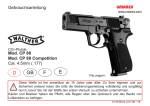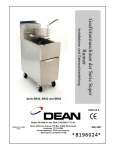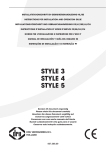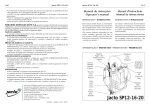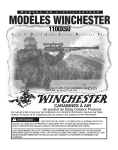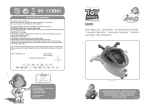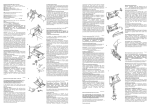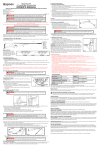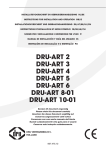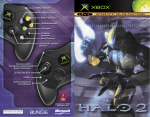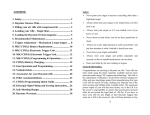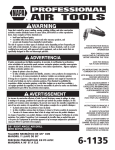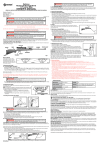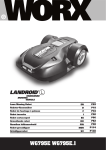Download 617/622 MANUAL multi-lang 36pg
Transcript
O p e r a t English i o n M a n u a l POWERLINE MODEL 617X/622X SERIES C O 2 S e m i a u t o m a t i c 617X .177cal. (4.5mm) LEAD AIRGUN PELLET .177 cal BB (4.5 mm) STEEL AIRGUN SHOT 12gm CO2 cylinder only 622X .22 cal. (5.5mm) LEAD AIRGUN PELLET 12gm CO2 cylinder only By Daisy WARNING: NOT A TOY. ADULT SUPERVISION REQUIRED. MISUSE OR CARELESS USE MAY CAUSE SERIOUS INJURY OR DEATH. MAY BE DANGEROUS UP TO 268YARDS (238 METERS). THIS IS A HIGH POWER AIR GUN RECOMMENDED FOR USE BY THOSE 16 YEARS OF AGE OR OLDER. READ ALL INSTRUCTIONS BEFORE USING. THE PURCHASER AND USER SHOULD CONFORM TO ALL LAWS GOVERNING USE AND OWNERSHIP OF AIR GUNS. WARNING: THIS GUN CAN CAUSE DEATH IF CARELESSLY USED OR MISUSED. READ AND FOLLOW THE INSTRUCTIONS CAREFULLY. DO NOT INSTALL A CLIP WHICH CONTAINS AMMUNITION INTO THE GUN UNTIL YOU ARE READY TO SHOOT. IF YOU DO INSTALL A CLIP WHICH CONTAINS AMMUNITION INTO THE GUN AND THEN DECIDE NOT TO SHOOT, EITHER MANUALLY REMOVE THE CLIP FROM THE GUN OR SHOOT THE REMAINING AMMUNITION AT A SAFE TARGET. AN UNLOADED, NON-PRESSURIZED GUN WHICH IS “ON” SAFETY IS SAFEST. ACCIDENTS HAPPEN FAST, AND ACCIDENTALLY INJURING OR KILLING SOMEONE IS A TERRIBLE THING. PLEASE SHOOT SAFELY. This safety alert symbol indicates important safety messages in this manual. When you see this symbol, be alert to the possibility of personal injury and carefully read the message that follows. The Model 617X/622X CO2 PowerLine pistol shoots with much more muzzle energy than most BB and pellet guns. Use extreme caution when operating this gun. Although your new PowerLine pistol is not a firearm, it has lethal potential and should be treated with the caution and respect due any conventional firearm. Like a firearm, your PowerLine pistol, when musused or carelessly used, can kill or seriously injure the shooter or other persons. Always remember, the first and most important safety feature of any gun is the shooter. All safeties are mechanical devices and the shooter is the only part of the system that can make a gun safe–or unsafe. DON’T DEPEND ON MECHANICAL SAFETIES–think ahead and avoid situations that might lead to accidents. Guns differ in their operation, and you are never ready to fire any gun until you are thoroughly familiar with it. Read the following operating instructions and WITHOUT LOADING ANY AMMUNITION, proceed through the operating steps, dry firing your gun with CO2 only several times at a safe target. This will enable you to learn to operate the PowerLine 617X/622X properly and safely. PRIOR TO OPERATION PUT “ON SAFETY”–POSITION SAFETY LEVER TO COVER RED DOT (refer to page 5). REAR SIGHT BARREL HOUSING LATCH HAMMER MUZZLE SAFETY TRIGGER GRIP FIG. 1 FRONT SIGHT PUNCTURE SCREW 2 OPERATION STEPS WARNING: Be sure gun is always pointed in a safe direction. Insert CO2 cylinder. Step 1. Put "ON" safety - red dot covered. Step 4. Aim at safe target. Step 2. Load Step 5. Take "OFF" safety - red dot showing. Step 3. Cock hammer. Step 6. Fire. Gun can continue to be shot until the ammunition clip or the CO2 cylinder needs to be replaced. The Model 617X/622X will obtain a minimum of 60 shots per CO2 cylinder. Refer to section on CO2 characteristics on page 7. NEVER STORE A LOADED GUN At the end of a shooting session, as a safety precaution, always put “ON” safety (refer to page 5), remove CO2 cylinder (refer to page 6), remove clip from pistol (refer to page 5), and remove any ammunition from the clip. (refer to page 5). Store in a safe place to prevent unauthorized use. INSERT CO2 CYLINDER 1. 2. 3. 4. Put "ON" safety - red dot covered. Remove left grip cover by lifting the grip cover tab (Figure 2). Turn puncture screw counterclockwise until there is enough room to insert a CO2 cylinder. Insert the large end of the CO2 cylinder into the lower portion of the grip. Hold the gun in an inverted position with the grip pointing up and the muzzle pointing away from you as shown (Figure 2B). Position the small end of the CO2 cylinder inside the retainer so that the CO2 cylinder touches the puncture pin (Figure 2A). 5. While continuing to hold gun in an inverted position, replace the left grip cover, point the muzzle in a safe direction and turn the puncture screw clockwise to puncture the CO2 cylinder. Continue turning the screw RAPIDLY until finger tight. NOTE: A slight seepage of CO2 gas may occur until puncture screw is tight. PUNCTURE PIN FIG. 2 FIG. 2A RETAINER GRIP COVER FIG. 2B PUNCTURE SCREW GRIP COVER TAB WARNING: Be sure the muzzle is pointed in a safe direction when puncturing a CO2 cylinder. In the event that a seal temporarily leaks while a CO2 cylinder is being punctured, the CO2 gas may escape through the barrel. If ammunition is lodged in the barrel from prior shooting, this could result in a projectile being shot. WARNING: Use only 12 gram CO2 cylinders. Any attempt to use other types of gas cylinders could be extremely dangerous and could result in serious injury. Gasses other than CO2 could result in an explosion or rupture of the gun. 3 NOTE: Model 622X shoots .22 caliber (5.5 mm) pellets only. The Model 617X shoots .177 caliber (4.5 mm) pellets and/or BBs. FIG. 3 LOAD ROTARY CLIP 1. Open breech of pistol by pulling back the barrel housing latch. While holding the pistol muzzle down. pull upward on barrel housing to open breech (Fig.5). 2. Remove rotary clip and Insert a total of six projectiles into the rotary clip ( M o d e l 6 2 2 x : . 2 2 c a l . pellets only Model 617X: .177 cal. p e l l e t s a n d / o r B B s ) (Figure 3). HOW TO OPERATE WARNING: Be sure gun is always pointed in a SAFETY HAMMER FIG. 4 safe direction. Step 1. PUT "ON" SAFE - RED DOT COVERED. Rotate the safety toward the "SAFE" position (See Figure 4). With the safety in this position, the trigger CAN be pulled although the gun will not discharge any CO2 or pellet. NOTE: The safety is not automatic. It will only do its job when you do yours. REMEMBER, THE BEST SAFETY IS GOOD GUN HANDLING. Step 2. LOAD FIG. 5 Pull back the barrel housing latch while holding the pistol muzzle down, pull upward on barrel housing to open breech (Figure 5). Insert a loaded clip fully into breech of barrel (Figure 6). Close barrel housing. Step 3. COCK HAMMER Point the gun in a safe direction. Pull the hammer back fully so that the hammer will stay cocked when released. Step 4. AIM AT SAFE TARGET To be a consistent marksman, use the correct sight picture each time you fire the pistol (Figure 7). CAUTION: Due to the power of this CO2 gas gun, use extra caution in selecting a safe target backstop. The Model 617X/622X should not be used with B•B gun target backstops when shooting pellets. Pick targets that cannot be penetrated or that will not cause a ricochet because of their hard surfaces. Use only targets and traps that are designed for use with high-powered pellet guns. The Model 617X should not be used with target traps designed for pellets when shooting BBs. Do not shoot at the surface of water. 4 FIG. 6 CORRECT SIGHT PICTURE REAR SIGHT FIG. 7 BULLSEYE FRONT SIGHT Step 5. TAKE "OFF" SAFE - RED DOT SHOWING. When you are certain that the target, backstop and sur-rounding area are safe, rotate the safety toward the "FIRE" position (Figure 8). Your gun is now ready to shoot. Pulling the trigger now will shoot a projectile out of the gun. In this condition, your gun should be handled with extreme care. Step 6. FIRE FIG. 8 The pistol can be safely fired after properly completing the operating steps mentioned above. After making sure the gun is pointed in a safe direction, gently but firmly, squeeze the trigger. If you desire to continue shooting, the operation steps can be repeated until the CO2 cylinder requires replacement. If a projectile does not fire after completing the operation steps, keep the gun pointed in a safe direction and make the following checks. 1. Safety is pointing to "FIRE". 2. Put safety "ON" (point to "SAFE") and check to see that a CO2 cylinder with sufficient CO2 gas is installed and tightened up against the puncture pin. 3. Refer to the section on "CO2 Characteristics" (See Page 7). WARNING: If the pistol still fails to shoot a projectile after checking the three items above and repeating the operation steps, there is a malfunction in the pistol. This could represent a dangerous condition. There could be ammunition in the pistol even though it did not shoot out. This could cause the user to mistakenly believe the pistol is unloaded. (Refer to "PISTOL MALFUNCTION" section to correct the problem). DECIDE NOT TO SHOOT Should you decide not to shoot after the hammer is cocked, UNLOAD THE GUN: A. Put "ON" safety - RED DOT COVERED. (refer to page 5) B. Remove the Rotary Clip. (refer to page 5) C. Remove the CO2 Cylinder. (refer to page 6) PISTOL MALFUNCTION The instructions given below are to be used when the pistol fails to shoot ammunition out of the barrel, or when the pistol is jammed. 1. REMOVE CO2 CYLINDER A. Put "ON" safety - RED DOT COVERED. B. With the left hand grip cover still in place, slowly turn puncture screw counterclockwise until any remaining CO2 gas is discharged. C. Remove left hand grip cover by lifting the grip cover tab. D. Remove CO2 cylinder from the pistol. 2. REMOVE THE ROTARY CLIP 3. CLEAR JAMMED AMMUNITION A. Insert a cleaning rod into the open end of the barrel and gently tap the jammed ammunition out of the breech end of the barrel. 4. SHOOT AMMUNITION OUT A. Insert a new CO2 cylinder (See Page 4). B. Shoot gun according to the operation steps beginning on Page 4. WARNING: If the pistol still fails to shoot ammunition out of the barrel, the pistol should have the CO2 cylinder removed, and the pistol should be sent directly to Daisy Outdoor Products Service Department. 5 CO2 CHARACTERISTICS There are occasions when a CO2 pistol may be subjected to abnormal conditions that can produce effects on the pistols performance. These conditions include operation and/or storage of the pistol at temperatures that are considerably higher or lower than normal outdoor temperatures (60˚-70˚F), as well as conditions of rapid fire. 1. High temperatures can produce pressure in the CO2 cylinder that is considerably higher than normal operating pressure. Such increased pressure may prevent the pistol from firing and may result in permanent damage to the gun. The maximum operating or storage temperature should not exceed 105˚F (40˚C). This temperature can easily be reached if the gun is left directly in the sun on a bright, sunny day. Therefore, the shooter should not expose the pistol to high temperature conditions or direct sunlight for any extended period of time. 2. Rapid firing of the gun will cause temperature reductions in the pistol and CO2 gas. This will result in lower pellet velocities and may even lower gas pressure enough so that the pistol will not fire. This condition can be especially apparent when shooting in cold weather. This condition can be avoided by allowing more time between shots. This permits the gas to increase in temperature and pressure and produce normal velocities. 3. During rapid fire, the muzzle velocity of each shot can be expected to decrease. This can be detrimental to shooting accuracy. Also, the faster the gun is shot, the fewer shots you will get per CO2 cylinder. 4. Care should be exercised to insure that the gun is not shot with a CO2 cylinder that is low in pressure. CAUTION: Shooting the gun with low CO2 pressure could result in ammunition lodging in the barrel. DRY-FIRE In order to dry-fire the Model 617X/622X, the barrel must be empty (See "How To Unload Pellets," below) then proceed to cock and fire the gun. HOW TO UNLOAD AMMUNITION 1. Put "ON" safety-RED DOT COVERED. 2. Take "OFF" safety and shoot gun in a safe direction to remove ammunition left in the gun. (or refer to Steps 1 & 2 under PISTOL MALFUNCTION, page 6). STORAGE Store your pistol unloaded. Put safety "ON", remove CO2 cylinder and unload the ammunition. Keep pistol away from children and untrained shooters. Store ammunition and CO2 cylinders separately from the pistol to keep them from untrained shooters. WARNING: A CO2 cylinder contains gas under pressure, whether or not it has been inserted into a gun. If exposed to high temperatures (such as inside of a closed car in direct sunlight), it could explode. Be sure to store all cylinders in a cool place. Protect your pistol from moisture and dirt. When not shooting, remove the CO2 cylinder, clean gun and wrap it in a smooth, dry cloth. Or, store the pistol in the package it came in when new. 6 PROPER CARE With care and periodic cleaning, your Model 617X/622X will provide many years of shooting enjoyment. As is the case with conventional firearms, abuse, neglect and continued exposure to the elements will impair the performance of any air gun. Learn to take care of your Model 617X/622X and it will serve you well. CAUTION: Never attempt to clean the Model 617X/622X until the safety is "ON", the pistol is empty of ammunition and the CO2 cylinder has been removed. EXTERIOR PARTS All the black plastic parts may be cleaned with a damp rag and mild soap or detergent. Avoid using strong detergent, abrasive cleaning compounds or solvents that may scratch or otherwise damage surfaces. LUBRICATION Your Model 617X/622X was lubricated when built and should not require any additional lubrication. MODIFICATION CAUTION: The components of the gun were engineered to deliver optimum performance. Any modification or tampering with a gun may cause a malfunction and may make it unsafe to use. Any change in performance (such as a lowered trigger force and shortened trigger travel) indicates possible wear, and such gun should be inspected, replaced or properly repaired by qualified personnel. Any gun that has been dropped should be checked by qualified personnel to ensure that its function has not been effected. WARNING: A GUN THAT IS NOT OPERATING PROPERLY MAY BE DANGEROUS. IT SHOULD BE KEPT SAFELY FROM USE BY ANYONE UNTIL REPAIRED OR DESTROYED. DO NOT TRY TO TAKE THE GUN APART. IT IS DIFFICULT TO REASSEMBLE, AND IMPROPER REASSEMBLY CAN CAUSE A HAZARDOUS CONDITION. REPAIR OF POWERLINE GUNS GUNS IN WARRANTY LIMITED ONE-YEAR WARRANTY For one year from date of purchase, Daisy will repair or replace and return this gun, free of charge, if defective in material or workmanship. Service is available by returning the gun to Daisy Outdoor Products (refer to important note below). Attach to the gun, your name, address, and telephone number, description of problem and proof of date of retail purchase (sales slip). Package and send transportation prepaid to Daisy. This Warranty gives you specific legal rights, and you may also have other rights which may vary from state to state. IMPORTANT: You can return your inoperative pistol to Daisy for repair via the U.S. Mail or United Parcel Service. Be sure to put “ON” safety, remove CO2 cylinder and unload Ammo from the Quick Change Clip before returning the gun to Daisy. You must include your street address for Daisy to send your pistol directly back to you through UPS delivery. GUNS OUT OF WARRANTY If your Daisy needs repair, please call 1-800-713-2479 for repair charges. Daisy will repair the gun or replace it with a reconditioned gun of the same model, if available; otherwise, with a model of equivalent quality. Daisy Outdoor Products Service Department 11823 Lime Kiln Rd. Neosho, MO 64850 U.S.A. 7 POWERLINE MODEL 617/622X PISTOL SPECIFICATIONS ACTION CALIBER CO2 powered semi-automatic – 617X – 622X AMMO CAPACITY .177cal. (4.5 mm) lead pellet or BB .22 cal. (5.5 mm) lead pellet 6-Shot rotary clip MAXIMUM SHOOTING DISTANCE* – 617X – 622X 268 yds. (238 meters) 235 yds. (215 meters) MAXIMUM VELOCITY – 617X – 617X – 622X 485 fps (148 mps) - BBs 425 fps (130 mps) - Pellets 400 fps (122 mps) - Pellets MUZZLE ENERGY 4.9 ft. lb. (6.6 J) BARREL 5.35 in. rifled steel SAFETY Rotary hammer block SIGHTS TRUGLO® fiber optic front; fixed open rear WEIGHT 1.3 lbs. (.59 kg) empty OVERALL LENGTH 8.5 in. (216 mm) POWER SOURCE Daisy 12gm CO2 small neck cylinder * With the muzzle pointed upward at the optimum angle CAUTION: CO2 cylinders may explode at temperatures above 160˚F (71˚ C) 8 CLUBS AND COMPETITION (United States customers) Throughout its history, Daisy Outdoor Products has supported many safety education and competitive target shooting programs. These programs have extended opportunities for hundreds of thousands of young shooters and adults to learn the responsibilities and skills that the shooting sports demand. Today, the company continues to provide teaching aids, special airguns, and turn-key kits so that camps, schools, and civic groups have the right materials to properly teach safe shooting skills. PROGRAM MATERIALS & EQUIPMENT Daisy Outdoor Products Special Market Programs 400 West Stribling Drive Rogers, AR 72756 PROGRAM INFORMATION National Guard Junior Marksmanship Program Details available from: MGMTU Camp Robinson North Little Rock, AR 72118-2200 AMERICAN LEGION JUNIOR SHOOTING SPORTS PROGRAM Details available from: The American Legion P.O. Box 1055 Indianapolis, IN 46206 DAISY/JAYCEES SHOOTING EDUCATION PROGRAM Details available from: The United States Junior Chamber of Commerce P.O. Box 7 Tulsa, OK 74121-0007 4-H SHOOTING SPORTS Contact your County Extension Agent JUNIOR OLYMPIC SHOOTING PROGRAM AND NRA JUNIOR CLUBS Details available from: National Rifle Association Competitions Div. 1600 Rhode Island Ave., N.W. Washington, D.C. 20036 9 By Daisy Daisy Outdoor Products R o g er s , A R 7 2757- 0 2 2 0 U .S .A . (501) 636-1200 800-643-3458 www.daisy.com REV. 07/03 PRINTED IN U.S.A. PART NO.138331-000 M a n u a l d e o p e r a c i ó n MODELO POWERLINE SERIE 617X/622X Pistola semiautomática de CO2 617X PERDIGONES DE PLOMO CALIBRE 0.177 (4.5 mm) BALINES DE BB, Cal., 0.177 (4.5 mm), de acero Cilindro de CO2 de 12 gramos únicamente 622X PERDIGONES DE PLOMO CALIBRE 0.22 (5.5 mm) Cilindro de CO2 de 12 gramos únicamente ADVERTENCIA: By Daisy NO ES UN JUGUETE. SE REQUIERE LA SUPERVISIÓN DE UN ADULTO. EL USO INDEBIDO O NEGLIGENTE PUEDE CAUSAR GRAVES LESIONES O LA MUERTE. PUEDE SER PELIGROSA HASTA UNA DISTANCIA DE 268 YARDAS (238 METROS). ÉSTA ES UNA PISTOLA DE AIRE COMPRIMIDO DE ALTA POTENCIA RECOMENDADA PARA PERSONAS DE 16 Ó MÁS AÑOS DE EDAD. LEA TODAS LAS INSTRUCCIONES ANTES DE USARLA. EL COMPRADOR Y EL USUARIO DEBEN CUMPLIR TODAS LAS LEYES SOBRE EL USO Y LA PROPIEDAD DE PISTOLAS Y RIFLES DE AIRE COMPRIMIDO. ADVERTENCIA: ESTE PISTOLA PUEDE CAUSAR LESIONES GRAVES, E INCLUSO LA MUERTE SI SE USA SIN CUIDADO O SE MANEJA MAL. LEA Y SIGA CUIDADOSAMENTE LAS INSTRUCCIONES. NO INSTALE UN CARGADOR QUE CONTENGA PERDIGONES EN LA PISTOLA HASTA QUE USTED ESTÉ LISTO PARA DISPARAR. SI USTED INSTALA UN CARGADOR QUE CONTENGA PERDIGONES EN LA PISTOLA Y ENTONCES DECIDE NO DISPARAR, EXTRAIGA MANUALMENTE EL CARGADOR DE LA PISTOLA O DISPARE LOS PERDIGONES RESTANTES CONTRA UN BLANCO SEGURO. UNA PISTOLA DESCARGADA Y SIN PRESIÓN Y CON EL SEGURO PUESTO ES LA MÁS SEGURA. LOS ACCIDENTES OCURREN RÁPIDAMENTE Y ES TERRIBLE LESIONAR O MATAR A ALGUIEN POR ACCIDENTE. POR FAVOR DISPARE CON SEGURIDAD. Este símbolo de alerta de seguridad llama la atención respecto a importantes mensajes de seguridad en este manual. Cuando usted vea este símbolo, manténgase alerta ante la posibilidad de que ocurran lesiones personales y lea cuidadosamente el mensaje que siga al símbolo. Los PowerLine Modelos 617X/622X los pistola de PowerLine disparan con más energía en la salida que la mayoría de los rifles de perdigones y BB. Use máxima precaución cuando manipula este arma de fuego. Aunque su nuevo PowerLine no es un arma de fuego, puede resultar mortal, y deberá tratarse con la precaución y respeto que merecen las armas de fuego convencionales. Como arma de fuego, su PowerLine, si se usa indebidamente o con negligencia, puede matar o herir seriamente a la persona que dispara o a otras personas. Recuerde siempre que el primer y más importante aspecto de la seguridad es el tirador. Los seguros son dispositivos mecánicos y el tirador es la única parte del sistema que puede hacer que una arma sea segura...o insegura. NO DEPENDA DE LOS SEGUROS MECÁNICOS; sino que piense hacia adelante para evitar situaciones que pudieran ocasionar accidentes. Cada pistola o rifle es diferente en cuanto a su modo de funcionamiento y usted nunca estará listo para disparar cualquier pistola o rifle hasta que esté completamente familiarizado con su uso. Lea las siguientes instrucciones de operación y SIN CARGAR NINGÚN PERDIGÓN, practique llevando a cabo los pasos de operación, dispare en frío su pistola con CO2 varías veces a un blanco seguro. Así podrá aprender a dominar su pistola modelo Power Line 617X/622X en forma correcta y segura. ANTES DE DISPARAR ACTIVE EL SEGURO, COLOQUE LA PALANCA DE SEGURIDAD DE FORMA QUE CUBRA EL INDICADOR ROJO (lea la explicación en la página 14). MIRA POSTERIOR SEGURO DE LA CAJA DEL CAÑÓN PERCUTOR BOCA DEL CAÑÓN SEGURO GATILLO EMPUÑADURA FIGURA 1 MIRA DELANTERA TORNILLO DE PERFORACIÓN 2 PASOS DE OPERACIÓN ADVERTENCIA: Asegúrese de que su pistola esté siempre apuntando en una dirección segura. Inserte el cilindro de CO2. Paso 1. Active el seguro, de forma que cubra el indicador rojo Paso 2. Cargue la pistola Paso 3. Amartille el percutor Paso 4. Apunte a un blanco seguro Paso 5. Desactive el seguro; podrá ver el indicador rojo Paso 6. Dispare Puede seguir disparando la pistola hasta que el cargador de perdigones esté vacío o sea necesario reemplazar el cilindro de CO2. Con el Modelo 617X/622X obtendrá un mínimo de 60 disparos por cada cilindro de CO2. Consulte la sección sobre las características de CO2 en la página 16. NUNCA GUARDE UNA PISTOLA CARGADA. Al final de cada sesión de tiro, como una precaución de seguridad, active siempre el seguro (vea la página 14), saque el cilindro de CO2 (vea la página 15), saque el cargador de la pistola (vea la página 14), y saque cualquier perdigón del cargador (vea la página 14). Guarde la pistola en un lugar seguro para impedir que pueda usarse sin autorización. INSERTE EL CILINDRO DE CO2 1. Active el seguro, de forma que cubra el indicador rojo. 2. Saque la cubierta izquierda de la empuñadura levantando la lengüeta de la cubierta de la empuñadura (Figura 2). 3. Gire el tornillo de perforación hacia la izquierda hasta que quede suficiente espacio para insertar un cilindro de CO2. 4. Inserte el extremo de mayor tamaño del cilindro de CO2 en la parte inferior de la empuñadura. Sostenga la pistola en posición invertida con la empuñadura apuntando hacia arriba y la boca del cañón apuntando lejos de usted como se muestra en la figura (Figura 2B). Coloque el extremo pequeño del cilindro de CO2 dentro del sujetador, de tal manera que el cilindro de CO2 toque el pasador de perforación (vea la Figura 2A). 5. Mientras sigue sosteniendo la pistola en posición invertida, vuelva a colocar la cubierta de la empuñadura en su sitio, apunte la boca del cañón en una dirección segura y gire el tornillo de perforación hacia la derecha para perforar el cilindro de CO2. Siga girando RÁPIDAMENTE el tornillo hasta que quede apretado al tacto. NOTA: Puede ocurrir una leve fuga del gas de CO2 hasta que el tornillo de perforación esté bien apretado. PASADOR DE PERFORACIÓN FIGURA 2 FIGURA 2A SUJETADOR CUBIERTA DE LA EMPUÑADURA FIGURA 2B TORNILLO DE PERFORACIÓN LENGÜETA DE LA CUBIERTA DE LA EMPUÑADURA ADVERTENCIA: Asegúrese de que la boca del cañón esté apuntando en una dirección segura al perforar el cilindro de CO2. En caso de que un sello deje escapar temporalmente el gas mientras se está perforando el cilindro de CO2, el gas de CO2 puede escapar a través del cañón. Si hay un perdigón en el cañón de una tanda anterior de disparos, esta situación puede provocar el disparo del perdigón. 3 ADVERTENCIA: Use únicamente cilindros de CO2 que sean del tipo de 12 gramos. Puede ser extremadamente peligroso intentar usar cualquier otro tipo de cilindros de gas, lo cual puede causar graves lesiones. El uso de otros gases, aparte del CO2, podría provocar explosiones o destrozar la pistola. NOTA: El Modelo 622x dispara perdigones calibre .22 (5.5 mm) solamente. El Modelo 617X dispara perdigones calibre .177 (4.5 mm) y/o BBs. FIGURA 3 CARGA DEL CARGADOR ROTATIVO 1. 2. SEGURO Abra la culata de la pistola tirando hacia atrás del seguro de la caja del cañón. Manteniendo la punta del cañón hacia abajo, tire hacia arriba de la caja del cañón para abrir la culata (Figura 5). Saque el cargador e inserte un total de seis proyectiles en el cargador rotatorio (Modelo 622X: .solamente perdigones calibre .22) El Modelo 617X: perdigones calibre .177 y/o BBs) (Fig. 3) CÓMO MANEJAR LA PISTOLA ADVERTENCIA: Asegúrese de que la pistola esté PERCUTOR FIGURA 4 siempre apuntando en una dirección segura. Paso 1. ACTIVE EL SEGURO, DE FORMA QUE EL INDICADOR ROJO QUEDE CUBIERTO. Haga girar el seguro hacia la posición "SAFE" (vea la Figura 4). Con el seguro en esta posición, SE PUEDE TIRAR DEL GATILLO aunque la pistola no descargará ni el gas de CO2 ni ningún perdigón. NOTA: La seguridad no es algo automático. El seguro cumplirá sus funciones únicamente cuando usted cumpla las suyas. RECUERDE: LA MEJOR SEGURIDAD CONSISTE EN MANEJAR BIEN LA PISTOLA. Paso 2. CARGUE LA PISTOLA Tire hacia atrás del seguro de la caja del cañón mientras sostiene la pistola con la boca del cañón apuntando hacia abajo: tire hacia arriba de la caja del cañón para abrir la culata (Figura 5). Inserte un cargador totalmente lleno en la culata del cañón (Figura 6). Cierre la caja del cañón. FIGURA 5 Paso 3. AMARTILLE EL PERCUTOR Apunte la pistola en una dirección segura. Tire del percutor totalmente hacia atrás, de tal manera que el percutor permanezca amartillado al soltarlo. Paso 4. APUNTE A UN BLANCO SEGURO Para disparar con puntería uniforme, use la forma correcta de la mira cada vez que dispare la pistola (Figura 7). ¡CUIDADO!: Debido a la potencia de este rifle de gas CO2, use mucha precaución al seleccionar un respaldo para el blanco seguro. El Modelo 617/622X no deberá usarse con respaldos para el blanco de rifle BB cuando dispara perdigones. Escoja blancos que no puedan ser penetrados o que no causarán rebotes debido a su superficie dura. Use solamente blancos y trampas que estén diseñados para usarse con rifles de perdigones de alta potencia. El Modelo 617X no deberá usarse con trampas de blanco diseñadas para perdigones cuando se disparan BBs. No dispare a la superficie del agua. 4 FIGURA 6 CORRECTA ALINEACIÓN DE LA MIRA MIRA POSTERIOR FIGURA 7 DIANA MIRA DELANTERA Paso 5. DESACTIVE EL SEGURO, VERÁ EL INDICADOR ROJO. Cuando usted tenga la seguridad de que el blanco, la plancha de contención y el área circundante están libres de peligro, haga girar el seguro hacia la posición "FIRE" (Figura 8). Su pistola estará lista para disparar en ese momento. Si tira del gatillo entonces, disparará un perdigón de la pistola. En este estado usted debe manejar su pistola con extrema cautela. Paso 6. DISPARE FIGURA 8 La pistola puede dispararse con seguridad después de completar los pasos mencionados anteriormente. Después de asegurarse de que la pistola esté apuntando en una dirección segura, oprima suavemente (pero con firmeza) el gatillo. Si desea seguir disparando, se pueden repetir los pasos de esta operación hasta que deba reemplazarse el cilindro de CO2. Si un perdigón no se dispara después de completar los pasos descritos de operación, mantenga la pistola apuntando en una dirección segura y compruebe lo siguiente: 1. El seguro está apuntando a "FIRE". 2. Active el seguro (apúntelo a "SAFE") y compruebe que el cilindro de CO2 tenga suficiente gas de CO2 y esté bien apretado contra el pasador de perforación. 3. Consulte la sección "Características del gas de CO2" (lea la explicación en la página 16). ADVERTENCIA: Si la pistola sigue sin disparar un perdigón después de dar los tres pasos de verificación, esto indica que hay un desperfecto en la pistola. Esto podría representar una condición peligrosa. Podría haber un perdigón en la pistola aun cuando no se logró disparar un perdigón. Esto podría inducir al usuario a creer erróneamente que la pistola está descargada. (Consulte la sección "Desperfectos de la pistola" para corregir el problema). SI USTED DECIDE NO DISPARAR Si usted decide no disparar la pistola después de amartillar el percutor. DESCARGUE LA PISTOLA: A. Active el seguro, DE FORMA QUE EL INDICADOR ROJO QUEDE CUBIERTO (lea la explicación en la página 14). B. Retire el cargador rotativo (lea la explicación en la página 14). C. Retire el cilindro de CO2 (lea la explicación en la página 15). DESPERFECTOS DE LA PISTOLA The instructions given below are to be used when the pistol fails to shoot a pellet out of the barrel, or when the pistol is jammed. 1. RETIRE EL CILINDRO DE CO2 A. Active el seguro, DE FORMA QUE EL INDICADOR ROJO QUEDE CUBIERTO. B. Dejando la cubierta de la empuñadura izquierda en su sitio, gire lentamente el tornillo de perforación hacia la izquierda, hasta descargar el resto deL gas de CO2. C. Retire la cubierta de la empuñadura izquierda levantando la lengüeta de la cubierta de la empuñadura. D. Retire el cilindro de CO2 de la pistola. 2. RETIRE EL CARGADOR ROTATIVO. 3. SAQUE EL PERDIGÓN ENCASQUILLADO. A. Inserte una varilla de limpieza en el extremo abierto del cañón y saque el perdigón encasquillado dando ligeros golpes a la pistola para sacarlo por la culata o por el extremo de la boca del cañón. 4. DISPARE EL PERDIGÓN A. Inserte un nuevo cilindro de CO2 (vea la página 13). B. Dispare la pistola siguiendo los pasos de operación descritos a partir de la página 13. ADVERTENCIA: Si todavía no se puede disparar un perdigón por el cañón de la pistola, esto indica que se debe sacar el cilindro de CO2 y enviar la pistola directamente al Daisy Outdoor Products Service Department (Departamento de servicio para productos Daisy de uso al aire libre). 5 CARACTERÍSTICAS DEL CO2 Hay ocasiones cuando una pistola de CO2 puede estar sometida a condiciones anormales que pueden producir efectos negativos sobre el rendimiento de la pistola. Entre estas condiciones está el manejo o el almacenamiento de la pistola a temperaturas que son superiores o inferiores a las temperaturas ambiente típicas (60-70°F ó 15-21°C), así como condiciones en las que la pistola se dispara rápidamente. 1. Las altas temperaturas pueden ejercer una mayor presión sobre el cilindro de CO2 por encima de la presión operativa normal. Esta mayor presión puede impedir que la pistola dispare y puede provocar daños permanentes a la pistola. La temperatura máxima de operación o almacenamiento no debe ser mayor de 105ºF (40ºC). Se puede llegar fácilmente a las temperaturas máximas de operación y funcionamiento si se deja la pistola directamente bajo el Sol en un día caluroso. Por consiguiente, el tirador no debe exponer la pistola a condiciones de alta temperatura ni dejarla bajo la luz solar directa durante ningún período extenso de tiempo. 2. Disparar rápidamente la pistola causará una reducción de la temperatura en la pistola y en el gas CO2. Esto ocasionará velocidades menores al disparar los perdigones y puede incluso disminuir la presión del gas hasta el punto en que la pistola simplemente no disparará. Esta condición se hace más evidente cuando se dispara en clima frío, pero puede evitarse dejando pasar más tiempo entre cada disparo. Esto permite que el gas CO2 aumente su temperatura y su presión, y produzca así velocidades normales. 3. Durante los disparos en rápida sucesión, se puede esperar que disminuya la velocidad inicial de cada disparo. Esto puede tener efectos perjudiciales sobre la precisión de tiro. Asimismo, mientras más rápido se dispare la pistola, menos disparos usted podrá realizar con el mismo cilindro de CO2. 4. Se debe tener cuidado para garantizar que la pistola no se dispare con un cilindro de CO2 que tenga baja presión. ¡CUIDADO!: Si se dispara una pistola que tenga una baja presión en el cilindro de CO2, un perdigón podría quedar alojado en el cañón y dispararse luego accidentalmente. DISPAROS EN FRÍO Para poder disparar en frío la pistola Modelo 617X/622X, el cañón debe estar vacío (vea abajo la sección "Cómo descargar los perdigones"), seguidamente proceda a amartillar y disparar la pistola. CÓMO DESCARGAR PERDIGONES 1. Active el seguro, DE FORMA QUE EL INDICADOR ROJO QUEDE CUBIERTO. 2. Desactive el seguro y dispare la pistola en una dirección segura para remover cualquier perdigón que haya quedado en la pistola (o consulte los Pasos 1 & 2 en la sección DESPERFECTOS DE LA PISTOLA, página 15). ALMACENAMIENTO Almacene su pistola siempre descargada. Active siempre el "SEGURO", extraiga el cilindro de CO2 y saque el perdigón. Mantenga la pistola fuera del alcance de niños y tiradores sin entrenamiento. Almacene los perdigones, y los cilindros de CO2 separadamente de la pistola para evitar que caigan en manos de tiradores sin entrenamiento. ADVERTENCIA: Un cilindro de CO2 contiene gas bajo presión, independientemente de que el cilindro esté insertado o no en una pistola. Este cilindro puede explotar si se le expone a altas temperaturas (como las temperaturas que se producen en un vehículo cerrado y estacionado directamente bajo la luz solar). Asegúrese de guardar todos sus cilindros en un lugar fresco. Proteja su pistola contra la humedad y el sucio. Cuando no la esté disparando, saque el cilindro de CO2, limpie la pistola y envuélvala en un paño liso y seco. Como alternativa, guarde la pistola en el mismo empaque en el que llegó nueva a sus manos. 6 CUIDADO APROPIADO Con cuidado y limpiezas periódicas, su pistola Modelo 617X/622X le brindará muchos años de disfrute como tirador. Como ocurre con cualquier arma convencional de fuego, los abusos, el descuido y la continua exposición a la intemperie disminuirán el rendimiento de cualquier rifle o pistola de aire comprimido. Aprenda a cuidar su pistola Modelo 617X/622X y ella le brindará un buen servicio. ¡CUIDADO!: Nunca intente limpiar la pistola Modelo 617X/622X sin activar primero el seguro y sacar el cilindro de CO2 y todos los perdigones. PIEZAS EXTERNAS Todas las piezas plásticas negras pueden limpiarse con un paño húmedo y un jabón o detergente suave. Evite usar detergentes fuertes, compuestos limpiadores abrasivos o solventes que puedan arañar o dañar de otro modo las superficies. LUBRICACIÓN Su pistola Modelo 617X/622X fue lubricada adecuadamente durante su fabricación y no requiere ninguna lubricación adicional. MODIFICACIÓN ¡CUIDADO!: Los componentes de esta pistola fueron diseñados por ingenieros para dar un rendimiento óptimo. Cualquier modificación o manipulación de una pistola puede causar su mal funcionamiento y hacer que ya no se pueda usar la pistola con seguridad. Cualquier cambio en el rendimiento o el funcionamiento como, por ejemplo, una menor fuerza en el gatillo o un recorrido más corto del gatillo, indica el posible desgaste, modificación o manipulación indebida. Dicha pistola debe revisarse, reemplazarse o repararse apropiadamente a cargo de un personal calificado. Cualquier pistola que se haya caído golpeándose contra el suelo debe ser revisada por un personal calificado con el fin de asegurarse de que su funcionamiento no haya sido afectado por la caída. ADVERTENCIA: UNA PISTOLA QUE NO ESTÉ FUNCIONANDO CORRECTAMENTE PUEDE SER PELIGROSA. SE DEBE IMPEDIR SU USO POR PARTE DE CUALQUIER PERSONA HASTA SU REPARACIÓN O DESTRUCCIÓN. NO TRATE DE DESARMAR LA PISTOLA. ES DIFÍCIL VOLVER A ARMARLA Y SI SE COMETE ALGÚN ERROR AL VOLVER A ARMARLA, ESE ERROR PUEDE PROVOCAR UNA CONDICIÓN PELIGROSA. REPARACIÓN DE LAS PISTOLAS DAISY LAS PISTOLAS TIENEN UNA GARANTÍA LIMITADA DE UN AÑO Durante un año contado a partir de la fecha de compra, Daisy reparará o reemplazará esta pistola, gratuitamente, si tiene algún defecto en materiales o fabricación. Prestamos servicio de reparación si se devuelve la pistola a Daisy Manufacturing Co. (vea abajo la nota importante). Adjunte a la pistola su nombre, dirección y número telefónico, la descripción del problema y el comprobante de la fecha de compra al por menor (comprobante de compra). Embale la pistola y envíela a Daisy Manufacturing Co. con los gastos pagados de transporte. Esta garantía le otorga derechos legales específicos y usted también puede tener otros derechos que pueden variar de un estado a otro. IMPORTANTE: Usted puede devolver su pistola inservible a Daisy para su reparación a través del Servicio Postal de los Estados Unidos o a través del servicio expreso de United Parcel Service. Asegúrese de activar el seguro, sacar el cilindro de CO2 y descargar las municiones del Cargador de cambio rápido antes de devolver esta pistola a Daisy. Usted debe incluir la información sobre su domicilio para que Daisy pueda devolverle la pistola directamente a través del servicio de entregas de United Parcel Service (UPS). PISTOLAS SIN GARANTÍA Si su pistola Daisy necesita reparación, llame al teléfono de Servicio al Cliente 1-800-713-2479 para saber cuáles son los costos de la reparación. Daisy reparará o reemplazará la pistola con problemas con una pistola reacondicionada del mismo modelo, si hay disponibilidad de pistolas del mismo modelo; de lo contrario la reemplazará con un modelo de pistola de calidad equivalente. Daisy Outdoor Products Service Department 11823 Lime Kiln Rd. Neosho, MO 64850 U.S.A. 7 ESPECIFICACIONES DE LA PISTO LA POWERLINE MODELO 617X/622X ACCIÓN CALIBRE Pistola semiautomática de gas de CO2 – 617X – 622X Perdigones calibre 0.177 (4.5 mm) de plomo y balines Perdigones calibre 0.22 (5.5 mm) de plomo CAPACIDAD DE MUNICIONES Cargador rotativo de 6 perdigones DISTANCIA MÁXIMA DE DISPARO* – 617X – 622X 268 yardas (238 m)* 235 yardas (215 m)* VELOCIDAD MÁXIMA 485 pies por segundo (148 metros por segundo) - balines 425 pies por segundo (130 metros por segundo) - de plomo 400 pies por segundo (122 metros por segundo) - de plomo – 617X – 617X – 622X ENERGÍA INICIAL 4.9 pies lb. (6.6 J) CAÑÓN Acero tipo rifle de 5.35 pulgadas (136 mm) SEGURIDAD Bloqueo del percutor rotativo MIRAS Frontal TRUGLO® de fibra óptica; mira posterior fija y abierta PESO 1.3 lb. (0.6 kg) con la pistola vacía LONGITUD TOTAL 8.5 pulg. (216 mm) FUENTE DE POTENCIA Cilindro Daisy de CO2 de 12 gramos con cuello pequeño * Con la boca del cañón apuntando hacia arriba en un ángulo óptimo ¡CUIDADO!: Los cilindros de CO2 pueden explotar a temperaturas superiores a 160°F (71°C). 8 G u i d e d e l ’ u t i l i s a t e u r MODELE POWERLINE SÉRIE 617X/622X Revolver semi-automatique à CO2 617X PLOMBS POUR CARABINE À AIR COMPRIMÉ de calibre .177 pouce (4,5 mm) BILLES BB D'ACIER de calibre .177 (4,5 mm) Cartouche de CO2 de 12 grammes uniquement 622X PLOMBS POUR CARABINE À AIR COMPRIMÉ de calibre .22 pouce (5,5 mm) Cartouche de CO2 de 12 grammes uniquement AVERTISSEMENT : By Daisy CECI N’EST PAS UN JOUET. LA SURVEILLANCE D’UN ADULTE EST RECOMMANDÉE. L’USAGE ABUSIF OU NÉGLIGENT RISQUE DE CAUSER DES BLESSURES GRAVES OU LA MORT. CONSTITUE UN DANGER JUSQU’À 238 MÈTRES. CETTE ARME À AIR COMPRIMÉ EST UNE ARME À GRANDE PUISSANCE DONT L’EMPLOI EST RECOMMANDÉ AUX PERSONNES GÉES DE 16 ANS OU PLUS. PRIÈRE DE LIRE TOUTES LES INSTRUCTIONS AVANT D’UTILISER CETTE ARME. L’ACHETEUR ET L’UTILISATEUR DOIVENT SE CONFORMER AUX LOIS RÉGISSANT L’EMPLOI ET LA POSSESSION D’ARMES À AIR COMPRIMÉ. AVERTISSEMENT : CETTE ARME À FEU PEUT CAUSER DES BLESSURES GRAVES OU LA MORT EN CAS D’UTILISATION ABUSIVE OU NÉGLIGENTE. VEUILLEZ LIRE ET SUIVRE LES INSTRUCTIONS À LA LETTRE. NE PAS INSTALLER UN CHARGEUR RENFERMANT DES MUNITIONS DANS L’ARME AVANT D’ÊTRE PRÊT À TIRER. SI VOUS INTRODUSEZ UN CHARGEUR RENFERMANT DES MUNITIONS DANS L’ARME ET DÉCIDEZ DE NE PAS TIRER, VOUS DEVEZ ENLEVER LE CHARGEUR DE L’ARME MANUELLEMENT OU UTILISER LES MUNITIONS RESTANT DANS LE CHARGEUR EN TIRANT SUR UNE CIBLE SÛRE. UNE ARME NON CHARGÉE ET NONCOMPRIMÉE , DONT LE CRAN DE SÉCURITÉ EST ENGAGÉ, EST TOUJOURS PLUS SÛRE. UN ACCIDENT EST VITE ARRIVÉ, ET LE FAIT DE BLESSER OU DE TUER QUELQU’UN ACCIDENTELLEMENT EST IRRÉMÉDIABLE. UTILISEZ VOTRE ARME AVEC PRUDENCE. Ce symbole d’avertissement relatif à la sécurité indique des avis de sécurité importants contenus dans ce manuel. Lorsque vous apercevez ce symbole, soyez attentif à la possibilité de blessures corporelles et lisez bien le message qui suit. Les Modele 617X/622X les PowerLine tirent avec beaucoup plus d’énergìe initiale que les armes à balles BB ou à plombs. Il faut donc manipuler cette carabine avec une prudence extrême. Bien que la PowerLine ne soit pas une arme à feu, elle peut être mortelle et doit être traitée avec tout le respect dû à une arme à feu traditionnelle. Tout comme une arme à feu, lorsque votre PowerLine est mal utilisée ou utilisée imprudemment, elle risque de tuer ou de blesser gravement le tireur ou quelqu’un d’autre. Il ne faut jamais oublier que, dans toute arme à feu, la sécurité repose entre les mains du tireur. Tout dispositif de sûreté est mécanique et la personne qui tire est seule à pouvoir rendre une arme sûre – ou dangereuse. NE PAS DÉPENDRE DES DISPOSITIFS DE SÉCURITÉ – il faut avoir la vue longue et éviter les situations qui peuvent causer des accidents. Les armes obéissent à des modes de fonctionnement très variés et il convient d’être parfaitement rompu au maniement d’une arme avant de commencer à l’utiliser. Lisez la notice d’utilisation suivante et SANS CHARGER DE MUNITIONS, pratiquez le maniement de votre arme à CO2 en suivant son mode d’utilisation pas à pas et tirez plusieurs fois à vide en direction d’une cible sûre. Ceci vous permettra d’apprendre à utiliser le Power Line 617X/622X correctement et en toute sécurité. AVANT L’EMPLOI ENGAGEZ LE « CRAN DE SÛRETÉ » : PLACEZ LE LEVIER DE SÉCURITÉ DE FAÇON À RECOUVRIR LE POINT ROUGE (reportez-vous à la page 22). HAUSSE VERROU DE CANON CHIEN BOUCHE CRAN DE SÛRETÉ DÉTENTE CROSSE FIG. 1 GUIDON VIS PERFORANTE 2 MODE D’UTILISATION AVERTISSEMENT : Veiller à toujours pointer l’arme dans une direction sûre. la cartouche de CO2. Étape 1. ENGAGEZ le cran de sûreté (« ON ») - point rouge non visible. Étape 2. Chargez l’arme. Étape 3. Armez le chien. Introduisez Étape 4. Pointez l’arme sur une cible sûre. Étape 5. RELCHEZ le cran de sûreté (« OFF ») point rouge visible. Étape 6. Faites feu. Vous pouvez continuer de tirer jusqu’à ce qu’il soit nécessaire de remplacer le chargeur de munitions ou la cartouche de CO2. Le modèle 617X/622X vous permet de tirer au moins 60 coups par cartouche de CO2. Reportez-vous à la section relative aux caractéristiques du CO2 à la page 24. NE JAMAIS ENTREPOSER UNE ARME CHARGÉE À la fin d’une séance de tir, par précaution, engagez toujours le cran de sûreté (reportez-vous à la page 22), retirez la cartouche de CO2 (reportez-vous à la page 23), retirez le chargeur du pistolet (reportez-vous à la page 22), et retirez les munitions se trouvant dans le chargeur (reportez-vous à la page 22). Entreposez le pistolet dans un endroit sûr pour éviter toute utilisation non autorisée. INTRODUIRE LA CARTOUCHE DE CO2 1. ENGAGEZ le cran de sûreté (« ON ») - point rouge non visible. 2. Retirez la plaquette de crosse gauche en soulevant la languette prévue à cet effet (Figure 2). 3. Faites pivoter la vis perforante dans le sens contraire des aiguilles d’une montre jusqu’à ce qu’il y ait suffisamment de place pour introduire une cartouche de CO2. 4. Introduisez le bout large de la cartouche de CO2 dans la partie inférieure de la crosse. Tenez le pistolet à l’envers, la crosse dirigée vers le haut et la bouche dans la direction opposée de l’endroit où vous vous trouvez comme illustré (Figure 2B). Placez le petit bout de la cartouche de CO2 à l’intérieur de la patte de fixation de façon à ce que la cartouche de CO2 bute contre la broche de perforation (Figure 2A). 5. Tout en continuant de tenir le pistolet à l’envers, remettez la plaquette de crosse gauche en place, pointez la bouche du pistolet dans une direction sûre et faites pivoter la vis perforante dans le sens des aiguilles d’une montre pour percer la cartouche de CO2. Continuez de visser RAPIDEMENT (à la main seulement) jusqu’à ce que la vis soit vissée à fond. REMARQUE : Une légère fuite de CO2 risque de se produire tant que la vis perforante n’est pas vissée à fond. BROCHE DE PERFORATION FIG. 2 PATTE DE FIXATION FIG. 2A PLAQUETTE DE CROSSE FIG. 2B VIS PERFORANTE LANGUETTE DE LA PLAQUETTE DE CROSSE AVERTISSEMENT : Lorsque vous percez une cartouche de CO2, veillez à pointer la bouche du canon dans une direction sûre. En effet, si une fuite de gaz se produit momentanément dans un joint pendant la perforation d’une cartouche de CO2, une certaine quantité de gaz risque de s’échapper du canon. Hors, si une munition est restée coincée dans le canon au cours de la séance de tir précédente, celle-ci risque soudain d’être expulsée. 3 AVERTISSEMENT : Utilisez uniquement des cartouches de CO2 de 12 grammes. Toute tentative visant à utiliser un autre type de cartouche de gaz pourrait s’avérer extrêmement dangereuse et entraîner des blessures graves. L’utilisation d’un autre gaz que le CO2 peut provoquer une explosion ou faire éclater le pistolet. REMARQUE : Le Modèle 622X ne tire que des plombs de calibre 0,22 (5,5 mm). Le Modèle 617X tire des plombs de calibre 0,177 (4,5 mm) et/ou de calibre BB. FIG. 3 CHARGEZ LE CHARGEUR ROTATIF 1. Ouvrez la culasse du pistolet en tirant le verrou du bâti du canon vers l’arrière. Tout en maintenant la bouche du pistolet vers le bas, tirez vers le haut le bâti du canon pour ouvrir la culasse (Figure 5). 2. Retirez le chargeur rotatif et introduisez à l’intérieur six projectiles (Modèle 622X : plombs de cal. 0,22 uniquement. Modèle 617X : plombs de cal. 0,177 et/ou de cal. BB) (Figure 3). MANIEMENT DU RÉVOLVER AVERTISSEMENT : Veiller à toujours pointer le CRAN DE SÛRETÉ CHIEN FIG. 4 revolver dans une direction sûre. Étape 1. ENGAGEZ LE CRAN DE SÛRETÉ (« ON ») - POINT ROUGE NON VISIBLE. Faites pivoter le cran de sûreté jusqu’à ce qu’il se mette à la position de « SÉCURITÉ » (Voir la figure 4). Une fois le cran de sûreté en position de sécurité, même si l’on appuie sur la détente, le revolver n’expulsera pas de CO2 ni de plomb. REMARQUE : Le cran de sûreté n’est pas automatique. Il fonctionnera uniquement si vous avez su l’engager correctement. SOUVENEZ-VOUS QUE LE DISPOSITIF DE SECURITE LE PLUS FIABLE REPOSE SUR LE MANIEMENT SECURITAIRE DE L’ARME. FIG. 5 Étape 2. CHARGEZ Tirez le verrou du bâti du canon vers l’arrière tout en tenant la bouche du pistolet vers le bas ; tirez le bâti du canon vers le haut pour ouvrir la culasse (Figure 5). Introduisez un chargeur complet à l’intérieur de la culasse du canon (Figure 6). Refermez le bâti du canon. Étape 3. ARMEZ LE CHIEN Pointez le revolver dans une direction sûre. Tirez le chien à fond vers l’arrière jusqu’à ce qu’il reste sous tension lorsque vous le relâchez. Étape 4. VISEZ UNE CIBLE SÛRE Pour devenir tireur d’élite, vous devez utiliser un champ de visée à point à chaque coup de pistolet (Figure 7). PRÉCAUTIONS : Étant donné la puissance de ce revolver à CO2, vous devez faire montre d’une extrême prudence en choisissant une butte de tir sur cible sûre. Le Modèle 617X/622X ne doit pas être utilisé avec des buttes de tir sur cible destinées au tir à la carabine à air comprimé. Choisissez des cibles impénétrables ou qui ne risquent pas de faire ricocher les plombs en raison de leur surface dure. Utilisez uniquement des cibles et des trappes spécialement conçues pour l’emploi d’armes à plombs à grande puissance. Ne pas tirer en direction de l’eau. 4 FIG. 6 CHAMP DE VISÉE À POINT HAUSSE POINT DE MIRE GUIDON FIG. 7 Étape 5. RELÂCHEZ LE CRAN DE SÛRETÉ (« OFF ») - POINT ROUGE VISIBLE. Lorsque vous êtes certain de pouvoir utiliser la cible, la butte et le périmètre de tir en toute sécurité, faites pivoter le cran de sûreté pour le mettre dans la position « FEU » (Figure 8). Votre revolver est maintenant prêt à tirer. Le fait d’appuyer sur la détente aura désormais pour effet d’expulser un projectile. Dans ces conditions, votre revolver doit être manié avec d’infinies précautions. Étape 6. TIREZ FIG. 8 Après avoir effectué toutes les étapes du mode d’utilisation donné précédemment, vous pouvez faire feu en toute sécurité. Prenez bien soin de pointer le revolver dans une direction sûre et appuyez légèrement mais fermement sur la détente. Si vous désirez continuer de tirer, répétez les étapes du mode de fonctionnement jusqu’à ce que la cartouche de CO2 soit épuisée ou que vous deviez la remplacer. Si vous avez effectué toutes les étapes du mode de fonctionnement sans pour autant parvenir à tirer un projectile, faites les vérifications suivantes tout en prenant soin de pointer le revolver dans une direction sûre. 1. Le cran de sûreté est dirigé vers « FEU ». 2. ENGAGEZ le cran de sûreté (dans la position « SÉCURITÉ ») et vérifiez que le revolver contient bien une cartouche de CO2, que celle-ci est suffisamment pleine et qu’elle bute correctement contre la broche de perforation. 3. Reportez-vous à la section intitulée « Caractéristiques du CO2 » (voir page 24). AVERTISSEMENT : Si, après avoir effectué les trois vérifications précédentes et refait les étapes du mode d’utilisation, vous ne réussissez toujours pas à tirer un projectile, il est probable que le revolver est défectueux. Ceci peut constituer un danger pour la sécurité. En effet, le revolver peut contenir une munition même si aucun coup n’est parti. Mais l’utilisateur pourrait croire à tort que le revolver n’est pas chargé. (Reportez-vous à la section intitulée « Mauvais fonctionnement du revolver » pour tenter de remédier au problème). SI VOUS DÉCIDEZ DE NE PAS TIRER Si vous décidez de ne pas tirer après avoir armé le chien du revolver, DÉCHARGEZ-LE : A. ENGAGEZ le cran de sûreté (« ON ») - POINT ROUGE NON VISIBLE. (reportez-vous à la page 22) B. Retirez le chargeur rotatif (reportez-vous à la page 22) C. Retirez la cartouche de CO2 (reportez-vous à la page 23) FONCTIONNEMENT DEFECTUEUX DU REVOLVER Suivez les instructions suivantes si le revolver n’expulse aucune munition hors du canon ou s’il s’est enrayé. 1. RETIREZ LA CARTOUCHE DE CO2 A. B. ENGAGEZ le cran de sûreté (« ON ») - POINT ROUGE NON VISIBLE En laissant la plaquette de crosse gauche en place, faites pivoter lentement la vis perforante dans le sens contraire des aiguilles d’une montre jusqu’à ce que le CO2 restant soit expulsé. C. Retirez la plaquette de crosse gauche en la soulevant à l’aide de la languette prévue à cet effet. D. Retirez la cartouche de CO2 du revolver. 2. RETIREZ LE CHARGEUR ROTATIF 3. DÉGAGEZ LA MUNITION BLOQUÉE A. Enfoncez une baguette de nettoyage à l’intérieur de la bouche du canon et tapez légèrement sur la baguette pour débloquer la munition et l’expulser hors de la culasse ou de l’extrémité de la bouche du canon. 4. TIREZ LA MUNITION A. B. Insérez une cartouche de CO2 neuve (voir page 21). Tirez en suivant les étapes du mode d’utilisation débutant à la page 21. AVERTISSEMENT : Si le revolver ne parvient toujours pas à tirer une munition hors du canon, vous devez retirer la cartouche de CO2 et envoyer le revolver directement au service technique des produits de plein air de Daisy (Daisy Outdoor Products). 5 CARACTERISTIQUES DU CO2 Il arrive de temps en temps qu’un revolver au CO2 soit soumis à des conditions d’emploi anomales pouvant affecter sa performance. Parmi ces conditions, citons par exemple l’utilisation et/ou l’entreposage de l’arme à des températures extérieures nettement supérieures ou inférieures à la normale [15,6°-21,1° (C60°-70°F)], ou encore l’utilisation de l’arme dans des conditions de tir rapide. 1. Les températures élevées peuvent produire, dans la cartouche de CO2, une pression bien supérieure à la pression de service normale. Une telle hausse de pression est susceptible d’empêcher le revolver de tirer normalement et risque de l’endommager de manière irréversible. La température de fonctionnement ou d’entreposage maximum ne doit pas dépasser 40° C (105°F). Ce seuil de température peut être facilement atteint si le revolver est laissé au soleil lors d’une belle journée ensoleillée. Par conséquent, le tireur doit s’efforcer de ne pas soumettre le revolver à des températures élevées et de ne pas l’exposer à la lumière directe du soleil pendant de longues périodes. 2. Une grande cadence de tir produit des réductions de température à l’intérieur du revolver et de la cartouche de CO2. Ceci peut entraîner une réduction de la vitesse des plombs, voire une baisse de la pression du gaz, et empêcher le revolver de fonctionner normalement. Cette situation peut survenir particulièrement lors du tir par temps froid. Vous pouvez éviter le problème en laissant un intervalle de temps plus important entre chaque coup. Ceci permet à la température et à la pression du gaz d’augmenter et produit des vitesses normales d’expulsion des plombs. 3. Pendant le tir rapide, la vitesse initiale (à la bouche) de chaque coup de feu diminuera. Ceci peut avoir un impact nuisible sur la précision du tir. Par ailleurs, plus la vitesse de tir sera élevée, plus le nombre de coups sera faible pour chaque cartouche de CO2 utilisée. 4. Gardez-vous de tirer si le revolver contient une cartouche de CO2 dont la pression est faible. PRECAUTION : Si vous tirez avec une cartouche de CO2 dont la pression est faible, un plomb peut accidentellement rester coincé à l’intérieur du canon. TIR À VIDE Pour tirer à vide avec le modèle 617X/622X, vérifiez que le canon est vide (voir ci-dessous la section « Comment extraire les plombs »), puis armez le revolver et tirez. COMMENT EXTRAIRE LES MUNITIONS 1. ENGAGEZ le cran de sûreté (« ON ») - POINT ROUGE NON VISIBLE 2. RELÂCHEZ le cran de sûreté (« OFF ») et tirez dans une direction sûre pour expulser une munition restée dans le revolver. (Ou reportez-vous aux étapes 1 et 2 de la section « FONCTIONNEMENT DÉFECTUEUX DU REVOLVER », page 23). ENTREPOSAGE Entreposez votre revolver après l’avoir déchargé. Engagez le cran de sûreté (« ON ») (point rouge non visible), retirez la cartouche de CO2 et retirez les munitions. Gardez le revolver hors de la portée des enfants et des tireurs inexpérimentés. Rangez les munitions et les cartouches de CO2 séparément du pistolet afin de les tenir hors de portée des tireurs inexpérimentés. AVERTISSEMENT : Qu’elle soit ou non à l’intérieur d’un revolver, une cartouche de CO2 contient toujours du gaz sous pression. Si elle est exposée à des températures élevées (comme par exemple à l’intérieur d’un véhicule fermé et garé au soleil), elle risque d’exploser. Veillez à entreposer toutes vos cartouches dans un endroit frais. Protégez votre revolver contre l’humidité et la poussière. Lorsque vous ne tirez pas, retirez la cartouche de CO2 du revolver, nettoyez ce dernier et enveloppez-le d’un tissu doux et sec. Si vous préférez, entreposez le revolver dans son emballage d’origine. 6 ENTRETIEN NORMAL Régulièrement entretenu et nettoyé, le Modèle 617X/622X vous donnera beaucoup de satisfaction pendant de nombreuses années. Cela dit, tout comme pour les armes classiques, l’emploi abusif, la négligence et l’exposition permanente aux intempéries d’une arme à gaz aura pour effet d’en compromettre la performance. Apprenez donc à entretenir votre Modèle 617X/622X et vous en retirez de nombreuses satisfactions. PRECAUTION : Ne jamais procéder au nettoyage du Modèle 617X/622X avant d’avoir « ENGAGE » le cran de sûreté, de s’être assuré que le revolver ne contient aucune munition et d’avoir vérifié que la cartouche de CO2 a bien été retirée. PIECES EXTERIEURES Les pièces noires en plastique peuvent être nettoyées avec un chiffon humide et de l’eau savonneuse ou un détergent à vaisselle. Évitez d’utiliser des détersifs puissants, des produits de nettoyage à action abrasive ou des solvants qui risquent de rayer ou d’abîmer les surfaces pendant le nettoyage. LUBRIFICATION Votre Modèle 617X/622X a été huilé en usine durant la phase de fabrication et ne requiert aucune lubrification supplémentaire. MODIFICATION PRECAUTION : Les composants de cette arme ont été mis au point pour assurer une performance optimale. La modification ou l’altération d’une arme peut entraîner un défaut de fonctionnement et des conditions d’utilisation dangereuses. La modification des caractéristiques de fonctionnement (telles que la diminution de la force de détente ou la réduction de la course de la détente) sont des marques possibles d’usure, et une arme ainsi modifiée doit être inspectée, remplacée ou correctement réparée par un personnel qualifié. Une arme que l’on a laissé choir doit être examinée par un personnel qualifié pour vérifier que son fonctionnement n’a pas été compromis. AVERTISSEMENT : UNE ARME QUI NE FONCTIONNE PAS CORRECTEMENT PEUT CONSTITUER UN DANGER. ELLE NE DOIT PAS ÊTRE LAISSÉE À LA PORTÉE D’INDIVIDUS SUSCEPTIBLES DE L’UTILISER AVANT D’AVOIR ÉTÉ RÉPARÉE OU ELLE DOIT ÊTRE DÉTRUITE. N’ESSAYEZ PAS DE DEMONTER CETTE ARME. ELLE EST DIFFICILE A REMONTER ET UN REMONTAGE DEFECTUEUX PEUT CONSTITUER UN DANGER POUR LA SECURITE. RÉPARATION DES ARMES DAISY ARMES COUVERTES PAR LA GARANTIE GARANTIE LIMITEE DE UN AN Daisy s’engage à réparer ou à remplacer gratuitement cette arme dans l’éventualité d’un vice de forme ou d’un défaut de fabrication, ce pendant une période de un an à partir de la date d’achat. Pour faire réparer votre arme, renvoyez-la à Daisy Outdoor Products (reportez-vous à la note importante ci-après). Veuillez joindre vos nom, adresse et numéro de téléphone, une explication du problème et le reçu muni de la date d’achat (ticket de caisse). Faites un colis et envoyez-le port payé à Daisy. Cette garantie vous donne des droits légaux spécifiques et vous pouvez jouir d’autres droits qui varient d’un état à l’autre. IMPORTANT : Vous pouvez renvoyer votre revolver défectueux à Daisy pour réparation par la poste ou par United Parcel Service. Avant de renvoyer l’arme à Daisy, n’oubliez pas d’engager le cran de sûreté (« ON »), de retirer la cartouche de CO2 et d’extraire toute munition pouvant se trouver à l’intérieur du chargeur à chargement rapide. Vous devez fournir votre adresse postale afin que Daisy puisse vous retourner l’arme directement par UPS. ARMES NON COUVERTES PAS LA GARANTIE Si vous avez besoin de faire réparer votre arme Daisy, appelez le service clientèle au 1-800-713-2479 pour obtenir les coûts de réparation. Daisy réparera ou remplacera l’arme par une arme remise en état du même modèle, dans la mesure où un tel modèle est disponible, ou bien par un autre modèle de qualité égale. Daisy Outdoor Products Service Department 11823 Lime Kiln Road Neosho, MO 64850 U.S.A. 7 SPECIFICATIONS DU REVOLVER POWERLINE MODELE 617X/622X ACTION CALIBRE Action semi-automatique à CO2 – 617X – 622X Balles BB en Plomb de calibre .177 (4,5 mm) Plomb de calibre .22 (5,5 mm) CAPACITÉ DE MUNITIONS Chargeur rotatif de 6 coups DISTANCE DE VISEE MAXIMALE* – 617X – 622X 238 m (268 yds.) 215 m (235 yds.) VITESSE MAXIMALE 148 mps (485 fps) de Balles BB 130 mps (425 fps) de Plomb 122 mps (400 fps) de Plomb – 617X – 617X – 622X ENERGIE INITIALE 6.6 J (4.9 ft. lb.) CANON Acier rayé de 13, 5 cm (5.35 in.) CRAN DE SURETE Sécurité anti-chute rotative DISPOSITIFS DE VISEE Guidon en fibres optiques TRUGLO‚ ; hausse à cran de mire fixe POIDS 0,59 kg (1.3 lbs) vide LONGUEUR TOTALE 216 mm (8,5 in) SOURCE D’ENERGIE Cartouche de CO2 Daisy de 12 grammes à petit col * Avec la bouche pointée vers le haut à l’angle optimal PRECAUTION : à 71° C (160°F) Les cartouches de CO2 risquent d’exploser à des températures supérieures 8 B e t r i e b s a n l e i t u n g POWERLINE MODELL DER REIHE 617X/622X C O 2 S e l b s t l a d e r 617X Bleikugeln Für Luftpistolen mit Kaliber 0,177 (4,5 mm) Für Schrot vom Kaliber 0,177 (4,5mm) Stahl-Luftgewehr-Schrot 12 g CO2-Zylinder verwenden 622X Bleikugeln Für Luftpistolen mit Kaliber 0,22 (5,5 mm) 12 g CO2-Zylinder verwenden WARNUNG: By Daisy KEIN SPIELZEUG. BEAUFSICHTIGUNG DURCH ERWACHSENE IST ERFORDERLICH. MISSBRAUCH ODER FAHRLÄSSIGER GEBRAUCH KÖNNEN ZU SCHWEREN VERLETZUNGEN ODER ZUM TOD FÜHREN. DIE GEFAHRENZONE ERSTRECKT SICH ÜBER 238 METER. DIES IST EINE HOCHLEISTUNGS-LUFTPISTOLE FÜR DEN GEBRAUCH DURCH PERSONEN MIT EINEM ALTER VON MINDESTENS 16 JAHREN. ALLE ANWEISUNGEN VOR DEM GEBRAUCH LESEN. KÄUFER UND BENUTZER MÜSSEN ALLE GESETZE FÜR DEN GEBRAUCH UND BESITZ VON LUFTPISTOLEN BEFOLGEN. WARNUNG: BEI UNVORSICHTIGEM GEGRAUCH ODER MISSBRAUCH KAN DIESES GEWEHR SCHWERE ODER GAR TODLICHE VERLETZUNGEN VERURSACHEN. ALLE ANWEISUNGEN SORGFÄLTIG LESEN UND BEFOLGEN. EIN LADESTREIFEN MIT MUNITION DARF ERST BEI SCHIESSBEREITSCHAFT EINGELEGT WERDEN. FALLS EIN LADESTREIFEN EINGELEGT WURDE UND ANSCHLIESSEND DOCH NICHT GESCHOSSEN WERDEN SOLL, ENTWEDER DEN LADESTREIFEN MANUELL AUS DER PISTOLE NEHMEN ODER DIE RESTLICHE MUNITION AUF EIN SICHERES ZIEL VERSCHIESSEN. DER SICHERSTE ZUSTAND BESTEHT BEI UNGELADEN PISTOLE OHNE DRUCKBEAUFSCHLAGUNG IM GESICHERTEN ZUSTAND. UNFÄLLE PASSIEREN SCHNELL, UND ES IST SCHRECKLICH, WENN JEMAND UNBEABSICHTIGT VERLETZT ODER GETÖTET WIRD. BITTE MIT VORSICHT SCHIESSEN. Dieses Warnsymbol weist auf wichtige Sicherheitsinformationen in dieser Anleitung hin. Dieses Symbol erscheint, wenn die Möglichkeit einer Körperverletzung besteht, und die zugehörige Information muss aufmerksam gelesen werden. Die Modelle 617X/622X PowerLine schießen mit wesentlich stärkerer Mündungsenergie als die meisten anderen Schrot- und BB-Luftgewehre. Der Gebrauch dieses Gewehrs muss mit größter Vorsicht erfolgen. Obgleich Ihr neues PowerLine Feuerwaffe ist, kann sie tödlich sein und sollte mit der gleichen Vorsicht und dem gleichen Respekt wie jede herkömmliche Feuerwaffe behan-delt werden. Ihr PowerLine wie jede Feuerwaffe bei unsachgemäßem oder fahrlässigem Gebrauch den Schützen oder andere Personen töten oder ernsthaft verletzen. Denken Sie immer daran, dass der erste und wichtigste Sicherheitsfaktor eines jeden Gewehrs der Schütze ist. Sämtliche Sicherheitsvorrichtungen sind mechanische Geräte, und der Schütze allein kann ein Gewehr sicher – oder gefährlich – machen. VERLASSEN SIE SICH NIE AUF MECHANISCHE SICHERHEITSVORRICHTUNGEN - handeln Sie klug, und vermeiden Sie Situationen, die zu Unfällen führen können. Pistolen funktionieren auf verschiedene Weise, und keine Pistole sollte abgefeuert werden, bevor man nicht vollständig mit ihr vertraut ist. Die folgenden Bedienungsanweisungen müssen gelesen werden, und die Schritte müssen OHNE LADEN DER MUNITION nachverfolgt werden, wobei die Pistole mehrere Male zur Probe nur mit CO2 auf ein sicheres Ziel abgefeuert wird. Auf diese Weise können Sie den Gebrauch der Power Line 617X/622X richtig und sicher lernen. VOR DEM GEBRAUCH „SICHERN" – DEN SICHERUNGSHEBEL ÜBER DEN ROTEN ANZEIGER STELLEN (siehe Seite 30). HINTERES VISIER LAUFGEHÄUSESPERRE HAHN MÜNDUNG SICHERUNGSHEBEL ABZUG GRIFF ABB. 1 VORDERES VISIER GRIFFDURCHSTICHSCHRAUBE 2 BEDIENUNGSSCHRITTE WARNUNG: Dafür sorgen, dass die Pistole immer in eine sichere Richtung zeigt. Den CO2-Zylinder einsetzen. Schritt 1. „Sichern" – Der rote Anzeiger ist bedeckt. Schritt 2. Laden Schritt 3. Den Hahn spannen. Schritt 4. Auf ein sicheres Ziel richten. Schritt 5. „Entsichern" – Der rote Anzeiger ist sichtbar Schritt 6. Schießen. Die Pistole kann weiterhin abgefeuert werden, bis der Ladestreifen mit der Munition der CO2-Zylinder ausgewechselt werden muss. Das Modell 617X/622X kann mit einem CO2-Zylinder mindestens 60 Schüsse ausführen. Siehe den Abschnitt über die CO2 Eigen schaften auf Seite 32. NIEMALS EINE GELADENE PISTOLE AUFBEWAHREN Als Vorsichtsmaßnahme wird die Pistole am Ende der Schießübung immer GESICHERT (siehe Seite 30), der CO2-Zylinder wird herausgenommen (siehe Seite 31), der Ladestreifen wird aus der Pistole genommen (siehe Seite 30), und es wird alle Munition aus dem Ladestreifen genommen (siehe Seite 30). An einem sicheren Ort aufbewahren, um unbefugte Benutzung zu verhindern. DEN CO2-ZYLINDER EINLEGEN 1. „Sichern" – Der rote Anzeiger ist bedeckt. 2. Den linken Griffdeckel abnehmen, indem die Griffdeckelsperre abgehoben wird (Abbildung 2). 3. Die Durchstichschraube entgegen dem Uhrzeigersinn drehen, bis genug Platz zum Einlegen eines CO2Zylinders vorhanden ist. 4. Das größere Ende des CO2-Zylinders in den unteren Teil des Griffs einlegen. Die Pistole umgekehrt mit dem Griff nach oben und der Mündung von sich weg halten (siehe Abbildung 2B). Das kleinere Ende des CO2Zylinders in den Halter einlegen, so daß der CO2-Zylinder die Durchstichschraube berührt (Abbildung 2A). 5. Die Pistole immer noch umgekehrt halten und den linken Griffdeckel wieder anbringen. Die Mündung in eine sichere Richtung halten und die Durchstichschraube im Uhrzeigersinn drehen, um den CO2-Zylinder zu durchstechen. Es wird SCHNELL weitergedreht, bis sie handfest angezogen ist. HINWEIS: Bis die Durchstichschraube fest ist, kann ein wenig Gasleckage auftreten DURCHSTICHSCHRAUBE ABB. 2 ABB. 2A HALTER GRIFFDECKEL Abb. 2B DURCHSTICHSCHRAUBE WARNUNG: GRIFFDECKELSPERRE Beim Durchstechen eines CO2-Zylinders die Mündung immer in eine sichere Richtung weisen. Bei einer temporären Leckage der Dichtung beim Durchstechen des CO2-Zylinders kann CO2-Gas durch den Lauf entweichen. Befindet sich noch Munition von der vorherigen Schießübung im Lauf, könnte diese herausgeschossen werden. 3 WARNUNG: Nur CO2-Zylinder von 12 Gramm verwenden. Der Versuch, andere Größen von CO2-Zylindern zu verwenden, kann äußerst gefähr lich sein. Die Verwendung anderer Gase als CO2 kann zur Explosion oder zum Bersten der Pistole führen. HINWEIS: Für Modell 622X nur 0,22 (5,5 mm) Kaliber Kugeln verwenden. Für Modell 617X 0,177 (4,5 mm) Kaliber Kugeln und/oder Schrot verwenden. ABB. 3 DEN LADESTREIFEN FÜLLEN 1. 2. Das Lager der Pistole öffnen, indem die Laufgehäusesperre zurückgezogen wird. Die Mündung nach unten halten und das Laufgehäuse nach oben ziehen, um das Lager zu öffnen (Abb.5). Den Ladestreifen herausnehmen und insgesamt sechs Projektile einsetzen. (Modell 622x: nur 0,22 Kaliber; Modell 617x: 0,177 Kaliber Kugeln und/oder Schrot) (Abbildung 3). BEDIENUNG WARNUNG: Die Pistole muss immer in eine sichere Richtung zeigen. SICHERUNG HAHN ABB. 4 Schritt 1. „SICHERN" – DER ROTE ANZEIGER IST BEDECKT. Die Sicherung auf die Position „SICHER" drehen (siehe Abbildung 4). Bei dieser Position der Sicherung KANN der Abzug gedrückt werden, die Pistole entlädt jedoch kein CO2 und keine Kugel. HINWEIS: Die Sicherung ist nicht automatisch. Sie funktioniert nur, wenn der Schütze richtig vorgeht. NICHT VERGESSEN, DASS DIE BESTE SICHERUNG IN DER RICHTIGEN HANDHABUNG DER PISTOLE BESTEHT. Schritt 2. LADEN Schritt 3. DEN HAHN SPANNEN Schritt 4. AUF EIN SICHERES ZIEL ZIELEN Die Mündung der Pistole nach unten richten und die Laufgehäusesperre zurückziehen; das Laufgehäuse nach oben ziehen, um das Lager zu öffnen (Abbildung 5). Einen vollen Ladestreifen in das Lager des Laufs einlegen (Abbildung 6). Das Laufgehäuse schließen. ABB. 5 Die Pistole in eine sichere Richtung richten. Den Hahn vollständig zurückziehen, so daß er beim Loslassen in der gespannten Stellung bleibt. Ein konstanter Schütze benutzt bei jedem Schuss mit der Pistole das richtige Visierbild (siehe Abb. 7). VORSICHT: Auf Grund der Energie der CO2-Pistole muss die Wahl eines sicheren Zielanschlags mit Vorsicht erfolgen. Das Modell 617X/622X sollte nicht an Zielanschlägen für normale Luftpistolen verwendet werden. Die gewählten Ziele müssen sowohl undurchdringlich sein als auch Abprallen auf Grund der Härte der Oberfläche verhindern. Es dürfen nur Ziele und Fallen verwendet werden, die für den Gebrauch von Hochleistungs-Bleikugelpistolen vorgesehen sind. Modell 617X sollte nicht mit Zielanschlägen für Schrotkugeln verwendet werden, wenn BBs abgeschossen werden. Es darf nicht ins Wasser geschossen werden. 4 ABB. 6 RICHTIGES VISIERBILD HINTERES VISIER ABB. 7 DAS SCHWARZE VORDERES VISIER Schritt 5. „ENTSICHERN" – DER ROTE ANZEIGER IST SICHTBAR Wenn Sie sich vergewissert haben, dass das Ziel, der Anschlag und die Umgebung sicher sind, die Sicherung auf die Position „SCHIESSEN" drehen (Abbildung 8). Ihre Pistole ist jetzt schussbereit. Durch Betätigen des Abzugs wird ein Projektil abgefeuert. Die Bedienung muss jetzt mit äußerster Vorsicht erfolgen. Schritt 6. SCHIESSEN ABB. 8 Nachdem die oben erwähnten Schritte der Bedienung durchgeführt wurden, kann die Pistole jetzt sicher geschossen werden. Nachdem dafür gesorgt ist, dass die Pistole auf ein sicheres Ziel zeigt, wird sachte aber fest der Abzug gedrückt. Soll weiter geschossen werden, können die Bedienungsschritte wiederholt werden, bis der CO2-Zylinder ausgetauscht werden muss. Falls nach der Ausführung der Bedienungsschritte kein Projektil herauskommt, die Pistole auf ein sicheres Ziel halten und folgende Prüfungen vornehmen. 1. Die Sicherung zeigt auf „SCHIESSEN". 2. Die Sicherung auf „SICHER" stellen und nachsehen, ob ein CO2-Zylinder mit ausreichend CO2-Gas eingesetzt ist und fest an der Durchstichschraube anliegt. 3. Im Abschnitt „CO2-Eigenschaften" nachschlagen (siehe Seite 32). WARNUNG: Falls die Pistole nach der Prüfung der obigen drei Punkte immer noch kein Projektil abfeuert, liegt eine Funktionsstörung der Pistole vor. Dabei kann es sich um einen gefährlichen Zustand handeln. In der Pistole könnte sich Munition befinden, selbst wenn keine Bleikugeln abgefeuert wurden. Das kann den Benutzer irrtümlicherweise zu der Annahme führen, dass die Pistole entladen ist. (Im Abschnitt „Funktionsstörungen der Pistole" nachschlagen, um das Problem zu beheben.) SOLL NICHT GESCHOSSEN WERDEN Sollte nach dem Spannen des Hahns beschlossen werden, doch nicht zu schießen, DIE PISTOLE ENTLADEN: A. Sichern" – DER ROTE ANZEIGER IST BEDECKT (siehe Seite 30). B. Den Ladestreifen herausnehmen (siehe Seite 30) C. Den CO2-Zylinder herausnehmen (siehe Seite 31). FUNKTIONSSTÖRUNG DER PISTOLE Die nachfolgenden Anweisungen sind zu befolgen, wenn keine Munition aus der Pistole herauskommt oder wenn eine Bleikugel gehemmt ist. 1. DEN CO2-ZYLINDER HERAUSNEHMEN. A. Sichern" – DER ROTE ANZEIGER IST BEDECKT B. Mit dem linken Griffdeckel noch aufgesetzt die Durchstichschraube langsam entgegen dem Uhrzeigersinn drehen, bis alles restliche CO2-Gas entwichen ist. C. Den linken Griffdeckel abnehmen, indem die Griffdeckelsperre angehoben wird. D. Den CO2-Zylinder aus der Pistole nehmen. 2. DEN LADESTREIFEN HERAUSNEHMEN. 3. DIE HEMMENDE MUNITION ENTFERNEN. A. Einen Pistolenputzer in das offene Ende des Laufs einführen und die hemmende Munition vorsichtig aus dem Lager oder der Mündung des Laufs herausklopfen. 4. DIE MUNITION HERAUSSCHIESSEN A. Einen neuen CO2-Zylinder einlegen (siehe Seite 29). B. Die Pistole wie in den Betriebsschritten ab Seite 29 beschrieben schießen. WARNUNG: Wird immer noch keine Munition aus dem Lauf geschossen, den CO2-Zylinder herausnehmen und die Pistole direkt an das Daisy Outdoor Products Service Department schicken. 5 CO2-EIGENSCHAFTEN Unter bestimmten außergewöhnlichen Umständen kann die Leistungsfähigkeit einer CO2-Pistole beeinträchtigt werden. Dazu gehören Gebrauch bzw. Aufbewahrung der Pistole bei Temperaturen, die höher oder niedriger als typische Außentemperaturen (18 - 22°C) sind, sowie schnelles Feuern. 1. Hohe Temperaturen können im CO2-Zylinder einen Druck erzeugen, der beträchtlich über dem normalen Betriebsdruck liegt. Ein derartiger Druckanstieg kann das Abfeuern der Pistole unterbinden und kann die Pistole dauerhaft beschädigen. Die maximale Betriebs- oder Aufbewahrungstemperatur kann leicht erreicht werden, wenn die Pistole an einem hellen, sonnigen Tag direkt in der Sonne gelassen wird. Deshalb sollte der Schütze die Pistole nicht über längere Zeit hohen Temperaturen oder direkter Sonne aussetzen. 2. Schnelles Abfeuern der Pistole erzeugt einen Temperaturabfall in der Pistole und dem CO2-Gas. Dadurch wird die Geschwindigkeit der Bleikugeln verringert, und der Gasdruck kann so weit sinken, dass die Pistole nicht schießt. Dieser Zustand kann vermieden werden, indem mehr Zeit zwischen den Schüssen gegeben wird. Dadurch können Temperatur und Druck des CO2-Gases ansteigen, um normale Geschwindigkeiten zu erzeugen. 3. Bei schnellem Abfeuern ist zu erwarten, dass die Mündungsgeschwindigkeit jedes Schusses kleiner wird. Dadurch kann die Schussgenauigkeit nachteilig beeinflusst werden. Je schneller die Pistole gefeuert wird, umso weniger Schüsse stehen pro Zylinder zur Verfügung. 4. Es muss dafür gesorgt werden, dass die Pistole nicht abgefeuert wird, wenn der Druck im CO2-Zylinder niedrig ist. VORSICHT: Ein Abfeuern der Pistole bei niedrigem CO2-Druck kann dazu führen, dass die Munition nicht aus dem Lauf ausgestoßen wird. TROCKENFEUERN Um das Modell 617X/622X trockenzufeuern muss der Lauf leer sein (siehe „Herausnehmen von Bleikugeln" weiter unten). Dann wird der Hahn gespannt und die Pistole gefeuert. ENTFERNEN VON MUNITION 1. „Sichern" – DER ROTE ANZEIGER IST BEDECKT 2. „Entsichern" und die Pistole in eine sichere Richtung abfeuern, um die in der Pistole verbliebene Munition zu entfernen (oder die Schritte 1 und 2 im Abschnitt „FUNKTIONSSTÖRUNGEN DER PISTOLE" auf Seite 31 befolgen). AUFBEWAHRUNG Die Pistole im entladenen Zustand aufbewahren. SICHERN, den CO2-Zylinder herausnehmen und die Munition entfernen. Die Pistole von Kindern und ungeschulten Schützen fern halten. Munition und CO2-Zylinder getrennt von der Pistole auf-be-wahren, um sie von ungeschulten Schützen fern zu halten. WARNUNG: Ein CO2-Zylinder enthält unter Druck stehendes Gas, unabhängig davon, ob er in die Pistole eingesetzt ist oder nicht. Unter hohen Temperaturen (wie zum Beispiel in einem verschlossenen Auto in direkter Sonne) kann er explodieren. Es ist dafür zu sorgen, dass alle Zylinder an einem kühlen Ort aufbewahrt werden. Die Pistole vor Feuchtigkeit und Schmutz schützen. Bei Nichtbenutzung den CO2-Zylinder herausnehmen, die Pistole reinigen und in ein glattes, trockenes Tuch einwickeln. Oder die Pistole in der originalen Versandpackung aufbewahren. 6 SACHGEMÄSSE PFLEGE Mit Pflege und regelmäßigem Reinigen wird das Modell 617X/622X über viele Jahre Freude am Schießen bereiten. Wie auch bei herkömmlichen Feuerwaffen führen Missbrauch, Vernachlässigung und ständige Wettereinwirkung zur Beeinträchtigung der Leistungs-fähigkeit jeder Luftpistole. Lernen Sie, wie es gepflegt wird, und das Modell 617X/622X wird Ihnen gute Dienste leisten. VORSICHT: Das Modell 617X/622X darf erst gereinigt werden, wenn es GESICHERT ist, die Pistole keine Munition enthält und der der CO2-Zylinder herausgenommen wurde. ÄUSSERE TEILE Alle schwarzen Kunststoffteile können mit einem feuchten Tuch und milder Seife oder mildem Reinigungs mittel gereinigt werden. Keine starken Reinigungsmittel, Scheuermittel oder Lösungs mittel verwenden, um Kratzer und andere Oberflächenschäden zu vermeiden. SCHMIEREN Das Modell 617X/622X wurde im Werk geschmiert und sollte kein weiteres Abschmieren benötigen. MODIFIKATION VORSICHT: Die Komponenten der Pistole wurden im Hinblick auf optimale Leistung konstruiert und hergestellt. Alle Modifikationen oder unbefugte Abänderungen der Pistole können zu Funktionsstörungen führen und den Gebrauch gefährlich machen. Alle Änderungen im Betriebsverhalten (wie zum Beispiel kleinere Zugkraft für die Betätigung des Abzugs und kürzerer Weg des Abzugs) deuten auf möglichen Verschleiß hin. Solche Pistolen sollten inspiziert, ersetzt oder von qualifiziertem Personal sachgemäß repariert werden. Alle Pistolen, die heruntergefallen sind, sollten von qualifiziertem Personal geprüft werden um sicherzustellen, dass ihre Funktion nicht beeinträchtigt wurde. WARNUNG: EINE FEHLERHAFTE PISTOLE KANN GEFÄHRLICH SEIN. SIE MUSS SICHER VON JEGLICHEM GEBRAUCH FERNGEHALTEN WERDEN, BIS SIE REPARIERT ODER ZERSTÖRT WIRD. DIE PISTOLE DARF NICHT AUSEINANDERGENOMMEN WERDEN. DER ZUSAMMENBAU IST SCHWIERIG, UND FALSCHER ZUSAMMENBAU KANN GEFÄHRLICH SEIN. REPARATUR DER DAISY PISTOLEN PISTOLEN MIT GARANTIE BESITZEN EINE EINJÄHRIGE, BESCHRÄNKTE GARANTIE Für ein Jahr vom Kaufdatum bietet Daisy kostenlose Reparatur oder Ersatz sowie Rücksendung im Falle von Material- oder Verarbeitungsmängeln. Der Kundendienst steht zur Verfügung, wenn die Pistole an Daisy Outdoor Products zurückgeschickt wird (siehe nachstehenden wichtigen Hinweis). Der Pistole müssen Name, Adresse und Telefonnummer, eine Beschreibung des Problems und der datierte Kaufbeleg (Quittung) beigefüht sein. Die Sendung muss verpackt und frachtfrei an Daisy geschickt werden. Die Garantie gewährt bestimmte Rechte, und möglicher weise besitzen Sie weitere, von Staat zu Staat unterschiedliche Rechte. WICHTIG: Die fehlerhafte Pistole kann mit der Post oder United Parcel Service an Daisy zur Reparatur zurückgeschickt werden. Vor der Rücksendung an Daisy muss die Pistole GESICHERT, der CO2-Zylinder herausgenommen und die Munition aus dem Schnellladestreifen entfernt werden. Ihre Straßenadresse muss beigefügt werden, damit Daisy die Pistole direkt via UPS zurückschicken kann. PISTOLEN MIT ABGELAUFENER GARANTIE Falls Ihre Daisy repariert werden muss, rufen Sie bitte die Nummer 1-501-636-1200 (gebührenfrei innerhalb der USA) an, um die Reparaturkosten zu erfragen. Daisy repariert die Pistole oder ersetzt sie durch eine überholte Pistole des gleichen Modells, falls verfügbar, oder andernfalls durch ein Modell vergleichbarer Qualität. Daisy Outdoor Products Service Department 112823 Lime Kiln Rd. Neosho, MO 64850 U.S.A. 7 TECHNISCHE DATEN DER POWERLINE PISTOLE MODELL 617X/622X WIRKUNG KALIBER Halbautomatische Pistole mit CO2-Antrieb – 617X – 622X 4,5 mm Bleikugel, Stahl-Luftgewehr-Schrot 5,5 mm Bleikugel MUNITIONSKAPAZITÄT Ladestreifen mit 6 Schuss MAXIMALE SCHUSSWEITE* – 617X – 622X 238 m 215 m MÜNDUNG MAXIMALE – 617X – 617X – 622X 148 m/s - Stahl-Luftgewehr-Schrot 130 m/s - Bleikugel 122 m/s - Bleikugel MÜNDUNGSENERGIE 6,6 J LAUF 136 mm Gewehrstahl SICHERUNG Drehhahnblock VISIERE TRUGLO“ Faseroptik vorne; Feststehend offen hinten GEWICHT 0,59 kg Leergewicht GESAMTLÄNGE 216 mm ENERGIEQUELLE Daisy 12 g CO2-Zylinder mit kleinem Hals * Mit der Mündung unter optimalem Winkel nach oben gerichtet. VORSICHT: CO2-Zylinder können bei Temperaturen über 71°C explodieren. 8



































